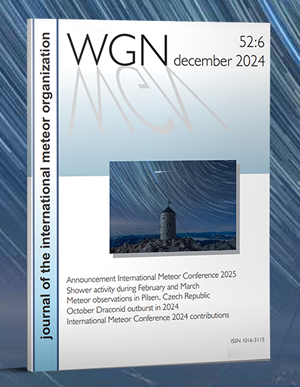During August observers in the northern hemisphere continue to see a rise in the meteor activity, especially near August 12, when the Perseids reach maximum strength. This peak is somewhat modified this year by the bright gibbous moon that will be present during the Perseid maximum. Observers south of the equator are seeing their rates plummet as the Perseids have little effect in producing activity from the far southern latitudes.
The moon reached its full phase on Wednesday August 9. This weekend the waning gibbous moon will rise during the late evening hours and will interfere with any attempts at viewing meteor activity. Not until late in this period, when the moon reaches its last quarter phase on Wednesday August 16, will conditions again be favorable for viewing. The sources of meteors listed below are active during this period but will be difficult to observe. If your sky is transparent and the limiting magnitude exceeds +5.0, then you may be able to achieve some success at observing during this period. The estimated total hourly rates for evening observers this week is near five for those in the Northern Hemisphere and two for those located in the Southern Hemisphere. For morning observers the estimated total hourly rates should be near twenty for those located in the Northern Hemisphere and seven for those in the Southern Hemisphere. These rates assume that you are watching from rural areas away from all sources of light pollution. The actual rates will also depend on factors such as personal light and motion perception, local weather conditions, alertness and experience in watching meteor activity. Rates are reduced this week due to intense moonlight.
The full descriptions of each active meteor shower will continue next week when the moon becomes less of a nuisance to observers.
Antihelion (ANT) – 22:12 (333) -08
Northern Hemisphere – 2 Southern Hemisphere – 2
Delta Aquarids (SDA) 23:24 (351) -12
Northern Hemisphere – >1 Southern Hemisphere – 1
Perseids (PER) 03:12 (048) +58
Northern Hemisphere – 15 Southern Hemisphere – 2




 You saw something bright and fast? Like a huge shooting star? Report it: it may be a fireball.
You saw something bright and fast? Like a huge shooting star? Report it: it may be a fireball.  You counted meteors last night? Share your results with us!
You counted meteors last night? Share your results with us!  You took a photo of a meteor or fireball? You have a screenshot of your cam? Share it with us!
You took a photo of a meteor or fireball? You have a screenshot of your cam? Share it with us!  You caught a meteor or fireball on video? Share your video with us!
You caught a meteor or fireball on video? Share your video with us!